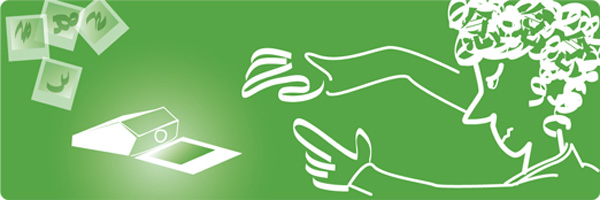- トップページ
- Fantastic Voyagers
- Clairvoyance – an obliterated field of research:

Clairvoyance - an obliterated field of research:
Often sensational and always controversial,
studies of clairvoyance (or “second sight”)
seem to have vanished from the history of science.
The scandalous story of the world’s first “thoughtograph” is a case in point.
Have you ever heard of a psychologist named Tomokichi Fukurai? An assistant professor and researcher at the Tokyo Imperial University in the early 20th century, he is famous as the discoverer of the process of “thoughtography” or “spirit photography.”
In 1910, Fukurai met a young woman from Kumamoto named Chizuko Mifune, who was known for her second sight, and together they carried out a number of experiments with clairvoyance. The results were published in Tokyo and became the talk of the town. Even a hundred years ago, the fact that a professor at Japan’s leading academic institution went public to announce the existence of psychic powers was quite sensational. Soon after, Mifune came up to Tokyo, and the pair attempted some demonstrations in front of other scientists and newspaper reporters, but unfortunately they didn’t go very well. The setup of the experiments was slipshod, and Mifune was denounced as a charlatan. The newspapers and magazines who so recently had made Dr. Fukurai the man of the day, now turned against him.
Next, Fukurai learned of another woman named Ikuko Nagao, whose premonitions reputedly often came true, and he enlisted her help to perform a new series of experiments. For these, they used unexposed photographic plates, onto which Nagao tried to project images by thought alone. This was the invention of “thoughtography.” However, once again Fukurai met with fierce criticism from his skeptics, who did everything they could to interfere with and cast doubts on his experiments.
The conclusion was that “clairvoyance is not scientific,” and in 1915, Dr. Fukurai resigned from his position at Tokyo Imperial University to pursue his research of the paranormal independently.
In 1933, Dr. Fukurai made new experiments with thoughtography, this time with a self-professed clairvoyant by the name of Koichi Mita. In particular, Mita claimed to capture images of the dark side of the moon, which no man had seen at the time. The question of whether they actually did look like the dark side of the moon had to wait for the development of the U.S. space project for its answer (Mita himself died in 1943), but when you compare his thoughtographs side by side with NASA’s photographs, it is hard to see any close resemblance.
Whether the psychic powers of Chizuko Mifune and Ikuko Nagao were authentic or not is impossible to verify today. Maybe they were complete frauds, or perhaps it was just the experiments that were unsuccessful. However, the media have a tendency to blow up a single mistake into a huge scandal, and the general public tends to follow their lead. Perhaps if Dr. Fukurai had been a bit more careful with his experimental setups, who knows? Maybe Japan’s history of paranormal research would have taken a different path. In actual fact, however, the very idea of paranormal research came to be seen as unscientific and became taboo in academic circles. Any scholar even attempting such research could wave goodbye to his academic career.
The world of science and academia is riddled with such forbidden topics. On the other hand, if you want to do the kind of research that could change the world, challenging precisely those taboos might be a way to start.
